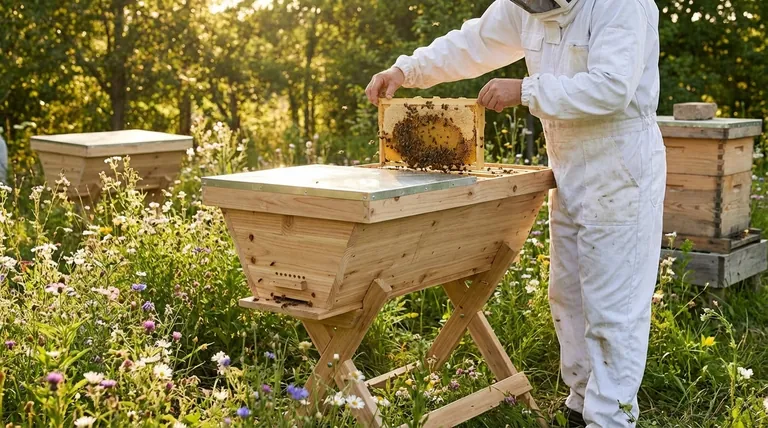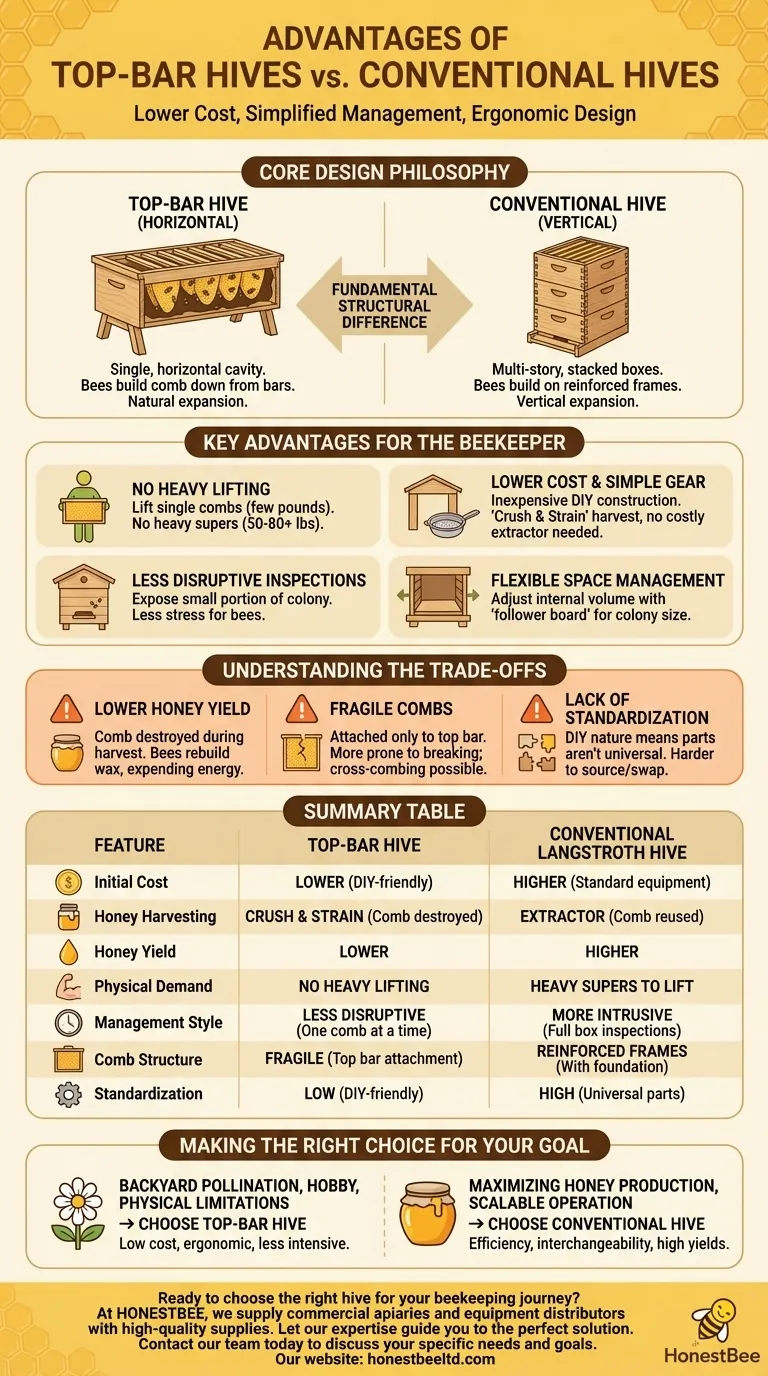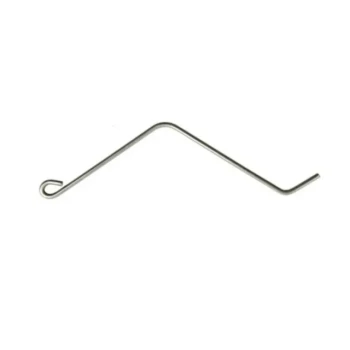In short, the primary advantages of top-bar hives are their lower cost, simplified management, and ergonomic design. Compared to conventional multi-story hives, they eliminate the need for heavy lifting, require less specialized equipment, and allow for a beekeeping style that is often considered less disruptive to the colony.
The choice between a top-bar hive and a conventional hive is not about which is definitively "better." It is a decision that aligns your equipment with your personal goals, physical abilities, and beekeeping philosophy.
The Core Design Philosophy: Horizontal vs. Vertical
The advantages of a top-bar hive stem directly from its fundamental structural difference from a conventional Langstroth hive.
A Single, Horizontal Cavity
A top-bar hive consists of a single, long horizontal box that typically sits on legs. Instead of frames, the bees build their comb down from simple wooden bars that rest across the top of this box.
This design mimics a more natural cavity, like a hollow log. The colony expands horizontally along the bars rather than vertically into stacked boxes.
Simplified Construction
Because there are no additional boxes to stack, the exact dimensions of a top-bar hive are not critical. This simplicity means they can be easily and inexpensively built from basic lumber or even scrap wood, dramatically lowering the initial investment.
Key Advantages for the Beekeeper
This horizontal design creates several practical benefits, especially for the backyard or hobbyist beekeeper.
Eliminating Heavy Lifting
Perhaps the most celebrated advantage is the elimination of heavy lifting. A conventional hive requires you to lift "supers"—boxes of honey that can weigh 50-80 pounds (22-36 kg) or more. In a top-bar hive, you only ever lift a single comb at a time, which weighs just a few pounds.
Lower Initial Costs and Equipment Needs
Beyond the low cost of the hive itself, top-bar beekeeping requires less gear. Honey is typically harvested by cutting the comb from the bar and using a "crush and strain" method. This completely avoids the need for a costly honey extractor.
Less Disruptive Inspections
When you inspect a top-bar hive, you remove only one or two bars at a time, exposing a very small portion of the colony. This is far less intrusive than removing the entire roof and inner cover of a conventional hive, which exposes the whole top of the colony to the elements and can be more stressful for the bees.
Flexible Space Management
Beekeepers use a solid divider called a follower board to control the amount of space the colony can use. This makes it easy to adjust the hive's internal volume for a growing colony, a small nucleus hive, or for winter, all within the same box.
Understanding the Trade-offs
To make an informed decision, you must weigh the advantages against the inherent limitations of the top-bar design.
Significantly Lower Honey Yield
The top-bar hive is not designed for maximizing honey production. Because the comb is destroyed during a crush-and-strain harvest, the bees must expend significant energy and resources to rebuild new wax comb each season. In a conventional hive, combs are reused, allowing bees to focus solely on filling them with honey.
Fragile, Unreinforced Combs
Combs in a top-bar hive are attached only to the top bar, with no side or bottom support. They are more fragile and can easily break off, especially during inspections in hot weather when the wax is soft. Bees may also attach the comb to the hive walls (cross-combing), making inspections difficult without damaging the comb.
Lack of Standardization
The DIY-friendly nature of top-bar hives means there is very little standardization of equipment. Bars from one hive will likely not fit in another, making it harder to source parts or swap resources compared to the universally standardized Langstroth system.
Making the Right Choice for Your Goal
Ultimately, the right hive depends entirely on your objectives.
- If your primary focus is backyard pollination, a low-intensity hobby, or you have physical limitations: The top-bar hive's low cost, ergonomic design, and less intensive management style make it an excellent choice.
- If your primary focus is maximizing honey production or a more scalable operation: The conventional Langstroth hive is purpose-built for efficiency, interchangeability, and high yields.
Choosing the right hive is the first step in creating a beekeeping experience that works for you and your bees.

Summary Table:
| Feature | Top-Bar Hive | Conventional Langstroth Hive |
|---|---|---|
| Initial Cost | Lower | Higher |
| Honey Harvesting | Crush and strain (comb destroyed) | Extractor (comb reused) |
| Honey Yield | Lower | Higher |
| Physical Demand | No heavy lifting | Heavy supers to lift |
| Management Style | Less disruptive, one comb at a time | More intrusive, full box inspections |
| Comb Structure | Fragile, attached only to top bar | Reinforced frames with foundation |
| Standardization | Low (DIY-friendly) | High (universal parts) |
Ready to choose the right hive for your beekeeping journey?
At HONESTBEE, we supply commercial apiaries and beekeeping equipment distributors with the high-quality, durable supplies needed for any operation, from large-scale honey production to smaller-scale hobbyist setups. Our wholesale-focused operations ensure you get reliable equipment at competitive prices.
Let our expertise guide you to the perfect solution. Contact our team today to discuss your specific needs and goals.
Visual Guide

Related Products
- Top Bar Beehive for Beekeeping Wholesales Kenya Top Bar Hive
- Long Langstroth Style Horizontal Top Bar Hive for Wholesale
- HONESTBEE Professional Multi-Functional Hive Tool with Ergonomic Wood Handle
- HONESTBEE Advanced Ergonomic Stainless Steel Hive Tool for Beekeeping
- HONESTBEE Professional Long Handled Hive Tool with Precision Cutting Blade
People Also Ask
- Which is better Kenya top bar hive or Langstroth? Choose the Right Hive for Your Goals
- How should a beekeeper prepare a top-bar hive for overwintering? A Guide to Ensure Colony Survival
- What are the benefits of extra wax production in top bar hives? A Natural Byproduct for Craft & Efficiency
- Why are hive inspections easier with Top Bar Hives? Achieve a Calmer, Safer Approach to Beekeeping
- What are the key features of the Kenyan Top Bar Hive? A Guide to Simpler, Natural Beekeeping



















